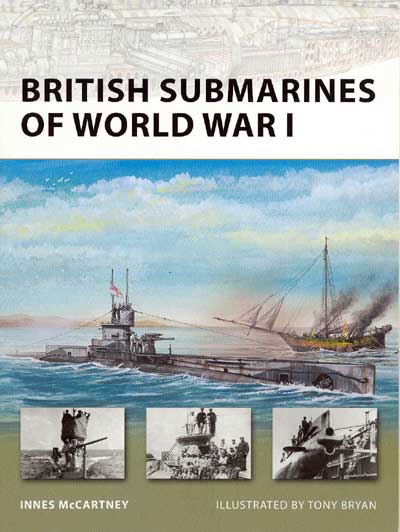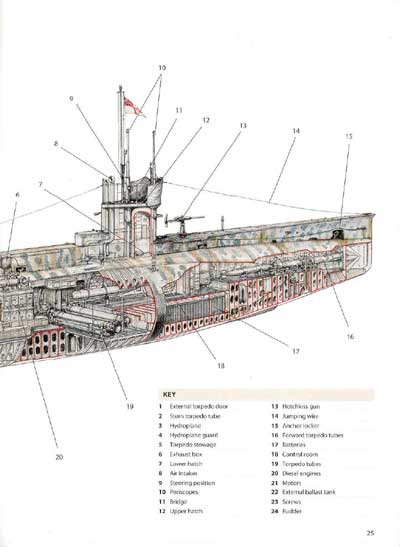British Submarines of World War I IntroductionThis is Innes McCartney’s second book in the New Vanguard series, and like the first, it covers British Submarines. The author is also a nautical archaeologist and among other wrecks, discovered the submarine monitor M1 which fittingly features in this book.
Article continues below…
Enjoy more Model Boats Magazine reading in the monthly magazine. Click here to subscribe & save. The BookThe book opens with a short introduction which acts as a reminder that the German U-Boats weren’t the only submarine force that successfully interdicted maritime trade during WW1. Following this is a detailed run-through of the classes of submarine operated by the Royal Navy, before and during the war. This section takes up about a third of the book and runs from the primitive Holland-derived coastal submarines to more developed E and H classes. The D, E and H classes get the most coverage (including data tables) which reflects their relative importance and success. One of the more surprising points made is that, prior to the D Class, Royal Navy submarines were powered by petrol engines! Large fleet submarines (classes J, K and M) are covered at the end of the section, though the author wisely refrains from recounting the numerous disasters that afflicted the K Class as these are covered well enough elsewhere and give a false impression of the effectiveness of the RN’s submarine arm. If the whole idea of the fleet submarine wasn’t odd enough, the M Class took it to extremes with a group of three submarine monitors armed with 12” guns. Understandably, the class was never used in action as fire control would have been a nightmare given the lack of the range-finding and director equipment installed on battleships. Two were converted to other purposes post-war, but M1 retained her gun until she was rammed and sunk off Start Point, where she still lies, and the author discovered her in 1999 (a misprint in the book puts the date of the sinking as 1915, it should be 1925). The remainder of the book is taken up with describing British submarines in action. The first theatre of action was the Baltic, with two submarines infiltrated in late 1914, to operate out of Russian naval bases. These proved so successful in interdicting shipments of iron-ore to Germany that further boats were sent, some via Archangel and others via a more direct route. By the end of 1915 the Germans were forced to institute a convoy system to reduce losses, and training of the German High Seas Fleet was hampered by torpedo attacks. The Russian Revolution meant the loss of the Russian naval bases, and the surviving submarines were scuttled to avoid handing them over to the Germans. One of the first two submarine captains to enter the Baltic was Max Horton, who during WW2 was commander Western Approaches, where he had to organise convoys and counter U-Boat attacks. No doubt his WW1 experience came in useful.
|
|
Activity in the Dardanelles against Turkish forces showed many similarities to the Baltic Campaign with Royal Navy submarines again operating in restricted waters. The levels of success were similar too, with merchant shipping almost entirely halted and Turkish Navy hard-hit, though the prizes targets of the Goeben and Breslau remained elusive. In contrast to the U-Boat campaign in the Atlantic though, all of the Royal Navy’s successes were carried out within international law. Operations in home waters proved more restricted, though there were notable successes like Horton’s sinking of the German cruiser Hela early in the war. It was as a U-Boat sinker though, that the British submarine found its most successful role, but this wasn’t until near the end of the war. Despite all the publicity given to Q-Ships, they were less effective than submarines which eventually accounted for 10% of U-Boat losses. Finally there is a list of all British submarine losses during WW1, which is reminder of the cost paid by the Royal Navy. ConclusionAlthough this book covers a fairly obscure subject, the content is interesting and (apart from a few stylistic tics) well-written. The photographs are well-chosen and usually have informative captions. Colour plates are excellent, as usual with the artist; small submarines are shown side-on, while the larger ones are shown in ¾ view which is an intelligent way of showing larger subjects on the small page size. Though camouflage schemes are shown and commented on, the colours used aren’t identified. This book offers a good counter-balance to the innumerable ones on U-Boats and reminder that they weren’t the only successful submarines. ContentsIntroduction Thanks to Osprey for providing the review sample.For full information on all Osprey Publishing titles, please see their website: Osprey Publishing
|
British Submarines of World War I
by
–
Advert
Enjoy more Model Boats Magazine reading every month. Click here to subscribe.
Article Tags:






